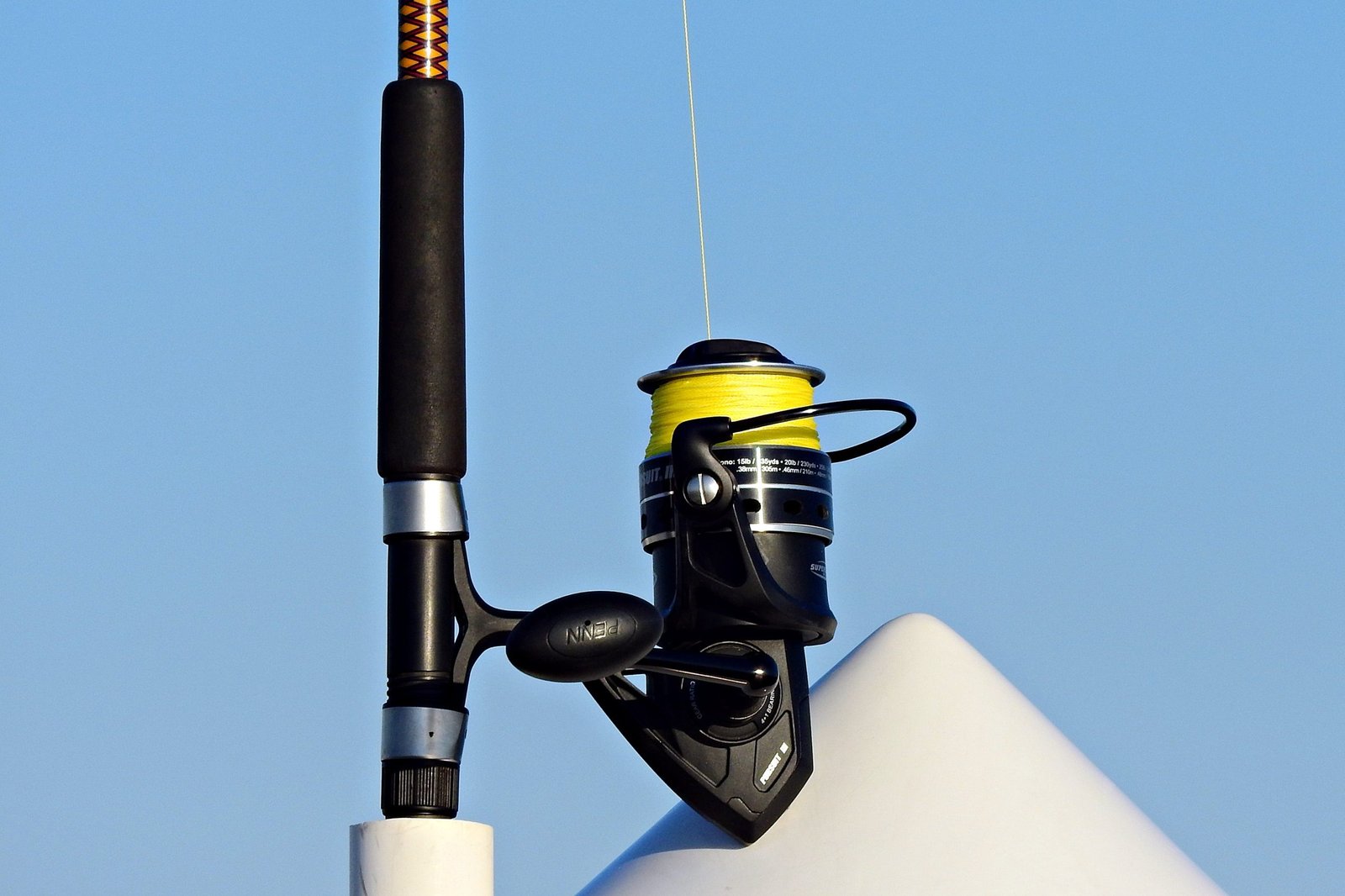
If jigging is your primary technique for bass and you need the best line for your setup, you’ve come to the right place. The right line can make a significant difference in terms of sensitivity, strength, and durability.
When jigging for bass, sensitivity is the name of the game. You want to be able to feel every nibble and bite, so you can quickly set the hook.
Braided lines are a popular choice for jigging because they offer excellent sensitivity and are incredibly durable. However, they can be challenging to tie knots with, and they are highly visible in clear water.
Monofilament and fluoro can also work, but are they the right choice?
Read on to discover the best lines on the market and what works best for you.
For those in a hurry, go straight to the options.
When to Use Different Line Types
Here I will discuss the three main line types and what they work best for, so you know which line to choose.
Braided Line
Braided line is made up of several strands of synthetic fibers that are woven together to create a single, strong line. It is known for its high strength-to-diameter ratio, which means that it can handle heavy loads without being too thick or bulky. Braided line is also highly visible, which can be an advantage when fishing in murky water or low light conditions.
One downside of braided line is that it has a lot of memory, which means that it tends to retain its shape after being spooled on a reel. This can make it difficult to cast and can also cause knots to slip. However, braided line is also highly abrasion-resistant, which makes it a good choice for fishing in rocky or weedy areas.
Monofilament Line
Monofilament line is made from a single strand of nylon or other synthetic material. It’s a good budget option for those who like a little bit of everything. It is a little sensitive, a little strong, may have low visibility, but doesn’t excel in any of them.
Although it’s not as sensitive as fluoro, it’s still a good option. Monofilament line also has a lot of stretch, which can help to absorb the shock of a fish’s sudden movements.
It also has good knot strength, which makes it easy to tie and secure your rigs.
Fluorocarbon Line
Fluorocarbon line is similar to monofilament line, but it is made from a different type of synthetic material. It is known for its invisibility, which makes it a good choice for fishing in clear water or when targeting fish that are easily spooked.
Fluorocarbon line is also highly sensitive, which makes it easy to detect even the slightest bite. It is also highly abrasion-resistant, which makes it a good choice for heavy cover.
One downside of fluorocarbon line is that it tends to be stiffer than other types of line, which can make it difficult to cast. It also has less stretch than monofilament line, which means that it may not absorb the shock of a fish’s sudden movements as well.
Take your time and see what fits you conditions the best.
Top Brands and Products
You need a line that is strong, sensitive, and reliable. After some research and analyzing, I have found several top brands and products that meet these criteria.
Berkley Trilene for Reliability
))/4007229.json)
Berkley Trilene is a well-known brand that has been producing fishing lines for years. Their Trilene XL and Trilene XT lines are both great options for jigging bass. Trilene XL is a monofilament line that is known for its reliability. It has low memory, which means it won’t twist or tangle easily. Trilene XT is a more abrasion-resistant line that is perfect for fishing in rocky areas.
Sufix Lines for Sensitivity
))/3761476.json)
Sufix is another reputable brand that produces high-quality fishing lines. Their Sufix Siege line is a great option for jigging bass. It is a monofilament line that is known for its sensitivity. This means you will be able to feel even the slightest bites. Sufix 832 Advanced Superline is another great option. It is a braided line that is incredibly strong and sensitive.
PowerPro and Spiderwire for Strength
))/3472454.json)
PowerPro and Spiderwire are two brands that are known for producing strong fishing lines. PowerPro Super Slick V2 is a braided line that is incredibly strong and durable. It has a smooth surface that allows it to cast farther and with less friction. Spiderwire Stealth is another great option. It is a braided line that is known for its strength and sensitivity. It has a thin diameter which allows it to cut through the water easily.
If you’re looking for a fluorocarbon line, the Seaguar Tatsu is the best you’re going to find on the market. It is incredibly strong, while keeping all the advantages fluorocarbon line has. It allows a natural presentation, so there is no chance of fish getting spooked by line.
Whether you are looking for reliability, sensitivity, or strength, there is a line on this list that will meet your needs and preferences.
Techniques for Effective Jigging
Jigging is a popular technique for catching bass, and it requires some skill and practice to master. In this section, I will discuss some of the techniques that can help you become more effective at jigging.
Mastering the Lift and Fall
One of the most important techniques in jigging is the lift and fall. This involves lifting the jig off the bottom and then letting it fall back down. The lift and fall mimics the movement of a baitfish, which can attract the attention of bass.
To perform the lift and fall, you should first cast your jig out and let it sink to the bottom. Then, you should lift the rod tip up slowly, which will lift the jig off the bottom. Once the jig reaches the desired height, you should let it fall back down naturally.
Hook Setting with Jigs
Another important technique in jigging is hook setting. Since jigs have a lack of stretch, it’s important to set the hook properly to ensure that the fish is hooked securely.
To set the hook with a jig, you should first feel for a bite or a change in weight on your line. Once you feel something, you should quickly reel in any slack and then pull the rod tip up sharply. This will drive the hook into the fish’s mouth and ensure that it’s hooked securely.
It’s also important to use the right type of jig for the conditions you’re fishing in. Swim jigs, chatterbaits, spinnerbaits, and topwater baits can all be effective for bass, but they each require a slightly different technique.
Frequently Asked Questions
What type of fishing line is most effective for jigging for bass?
When it comes to jigging for bass, fluorocarbon is considered the most effective type of line. It offers excellent sensitivity and low stretch, which allows for better detection of bites and better hook sets. Fluorocarbon also has low visibility underwater, making it less likely to spook fish.
What is the ideal pound test line for bass jigging?
The ideal pound test line for bass jigging depends on the weight of the jig and the cover you are fishing. For finesse jigs, a 6-8 lb line is sufficient. For heavier jigs and thicker cover, you may need to go up to 12-15 lb line. It is important to match your line weight to the conditions you are fishing in.
Is braided line or monofilament better suited for bass jigging applications?
Both braided line and monofilament have their advantages and disadvantages when it comes to bass jigging. Braided line offers excellent sensitivity and strength, making it ideal for fishing in heavy cover. Monofilament line has more stretch, which can help prevent fish from pulling off the hook, but it is less sensitive than braided line. Ultimately, the choice between the two comes down to personal preference and the conditions you are fishing in.
What are the advantages of using fluorocarbon line when jigging for bass?
Fluorocarbon line has several advantages when it comes to jigging for bass. It has low visibility underwater, which makes it less likely to spook fish. It also has excellent sensitivity and low stretch, allowing for better detection of bites and better hook sets. Fluorocarbon is also highly resistant to abrasion, making it ideal for fishing in heavy cover.
How does line color impact bass jigging success?
Line color can have an impact on bass jigging success, but it is not as important as other factors such as line weight and type. In clear water, a clear or low-visibility line is recommended to avoid spooking fish. In murky water, a high-visibility line can help you detect bites more easily.
For jig fishing, which is preferable: a spinning reel or a baitcaster setup?
Both spinning reels and baitcaster setups can be effective for jig fishing. Spinning reels are generally easier to use and are ideal for finesse techniques. Baitcasters offer greater accuracy and control, making them ideal for heavier jigs and thicker cover. Ultimately, the choice between the two comes down to personal preference and the conditions you are fishing in.
As an Amazon Associates member, I might earn a commission when you buy through the links on this page, at no additional cost to you. Thanks for helping me do what I like.




